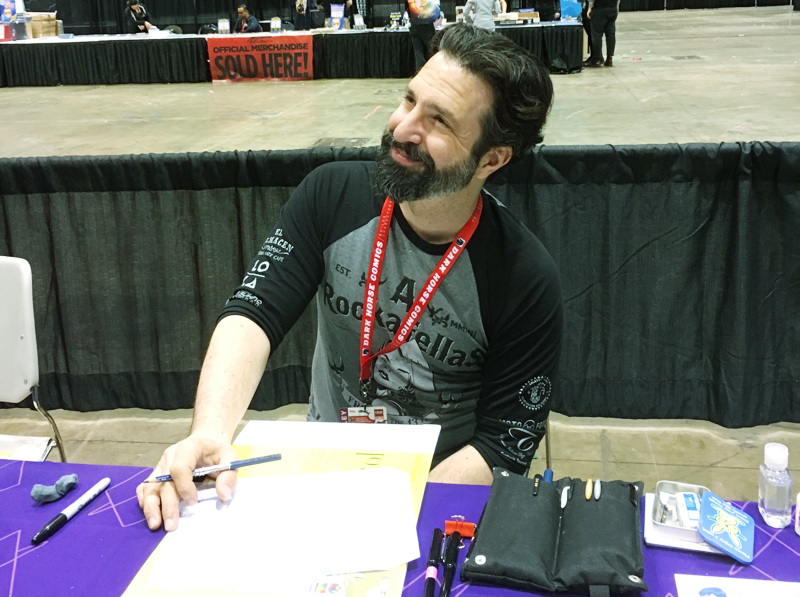by David Seidman for The Beat
Exhibiting at a comic-con, particularly in Artists Alley, can be fun and lucrative — or it can leave you frustrated, exhausted, and broke. Fortunately, you can take some control over which way the experience will go.
Believe me, I know. I’ve been an exhibitor for small and independent publishers at cons all over the country. I help my wife, cartoonist Lea Hernandez Seidman (DC’s Teen Titans Go! and other projects) with her Artists Alley appearances. And I work for UBM, a company that puts on conventions and trade shows.
Here’s what I’ve learned from my experience and the testimony of other exhibitors.
Where should you go?
Choosing a con is tough. Some exhibitors do well at huge shows like Comic-Con International San Diego or New York Comic-Con. Others make more money and have a better time at smaller shows. There’s not much consensus.
If you’re new at exhibiting, I’d follow the advice of journalist Nicole Dieker, an expert on small-scale money matters: “Since dealers’ tables tend to have a learning curve, it’s best to start small. Don’t apply to San Diego Comic Con during your first year as a dealer! Instead, find a small convention near your hometown.”
If possible, visit the show as an attendee before you set up as an exhibitor. You’ll learn how the show treats exhibitors and what’s likely to sell.

Products and prices
Once you decide where to go, you’ll have to deal with merchandise: What to bring, how much to bring, and how to price it.
Bring a variety of items — large prints, small prints, hardcover books, softcovers, and so on — that you can offer at a variety of prices. It’s a good way to provide something for every potential customer.
Check out how much other exhibitors are charging for products like yours. It’s a good way to determine how much you should charge for each item you want to sell.
Label your products’ prices clearly so that your customers won’t have to guess how much they cost.
Displays and designs
Give your display eye-catching, easily readable signage. “Have a well-designed banner with your signature and a strong image of a familiar character you’ve worked,” says Artists Alley veteran Scott Shaw (Sonic The Hedgehog, The Simpsons, The Flintstones).
Get a pull-up banner, especially if your exhibit space is small. Pull-up banners can run pretty tall, so people can see your name and art from a distance — always an advantage in a crowded exhibit hall. Make sure that the banner is narrow enough to fit in even the smallest exhibit space.
Put up a price-and-product list somewhere in your display. Make it easy for your visitors to see what they can buy.
Table essentials
Bring healthy snacks and lots of water to keep yourself from getting hungry, thirsty, and irritable.
Bring a tablecloth. Many cons will provide a table that’s bare, rough-looking, and often ugly. A handsome tablecloth makes your entire exhibit space look professional and can show off your work beautifully.
Bring business supplies: a cashbox, cash to make change, a credit-card reader, pens, pencils, paper, business cards, first-aid supplies, adhesive tape and other fasteners, protective sleeves or bags to keep your merchandise looking good, and an inventory sheet (on paper or on screen) to track everything that you’ve brought, everything that you’ve sold, and how much money you’ve made on each transaction.
Bring giveaways if you can afford to. Giveaways always attract visitors, especially kids. Some of the best giveaways are paper goods like bookmarks or postcards, because they can be bright and colorful, and they’re cheap to print. “A simple 8 1/2 X 11 with some art and information is a great thing to hand out,” Star Wars artist William O’Neill says. “Most will stop and take it, and many will then stop to look closer at your table or booth.”
Other pre-show essentials
Do the paperwork. This guideline falls into two parts. First, read the exhibitor manual, especially the rules for exhibitors. Second, fill out and send every single form that applies to you. You don’t want to show up at a con and have some bureaucrat block you from setting up at your table because you’re missing some form. Bring all of your documents with you to the show, even if you filed them online. Having them at hand will save you a lot of time and arguments.
Bring an aide or assistant. William O’Neill says, “Whenever possible, have someone manning the table with you so you help or chat with more than one potential customer and not get overwhelmed. Plus, you’ll have someone there to watch the table for bathroom/lunch breaks.”
Let people know where you’ll be. Social media is great for this purpose. Before and during the show, tell your followers and friends your booth or table number and when you’ll be there. At the show, post notes and photos (after getting the permission of the people you’re shooting, of course) of anything happening at your table. You can use the convention’s hashtag — for instance, #SDCC2018 or #C2E2 — to put your announcements into the general conversation about the show.
Meeting the customers
Be friendly to everyone who drops by. This is most important thing an exhibitor can do during a show. “If you sit there looking dour, no one’s gonna approach you,” says Artists Alley veteran Scott Shaw (Sonic The Hedgehog, The Simpsons, The Flintstones). “Engage the browsers. Ask ’em if it’s their first show, explain what you do, and generally try to enjoy yourself.”
Continue the friendly approach rather than pushing your merchandise too hard. While it’s great to show pride in your products, the high-pressure hard sell often pushes people away. Even if people knuckle under to your tactics and buy from you, they may resent and avoid you thereafter. But if they think of you as a friend, they’ll be delighted to buy your merchandise and help you prosper.
Stand up. It sounds like a small thing, and it can get wearing over the long days of a con. But as comics writer, commentator, and exhibitor Martha Thomases says, “Stand as much as you can so you can look people in the eye. It is much more welcoming and engaging.”
Be good to the other exhibitors, especially the ones located closest to you. You never know when you’ll need someone to lend you extra supplies or help you in any number of other ways. Besides, it’s better to spend day after day with people who like you rather than neighbors who are indifferent or hostile.
The big three-letter word
Have fun. Give yourself time to wander the exhibit hall, see friends, or just relax. Even working your table can be fun, because you’ll probably enjoy chatting with fans about the fannish stuff that you and they love. Not only is it enjoyable in itself, but it builds in fans the warm feelings that make them want to buy from you.
Good luck!
David Seidman has written, edited, and marketed comics. For more from him, visit his blog, https://davidleeseidman.wordpress.com/.







This is great feedback! Working the cons was rough yet it can be very fulfilling also with the help of the staff/volunteers there for the show! Great read and many artists would benefit. Most already do these things yet it’s s great reminder.
Thanks, Jenna. Glad you liked it.
This idea is covered in the “Do the paperwork” guideline, but it’s worth specifically mentioning tax forms. If there’s a requirement to file sales tax paperwork for the region of the show you’re exhibiting at, be sure to file that paperwork. You don’t want to get on the bad side of the tax guys; bureaucrat or not, they’re the guys who got Capone, after all…
Good point, Tommy.
Comments are closed.